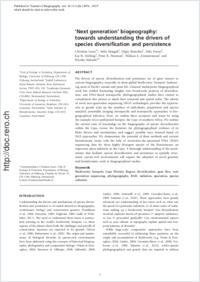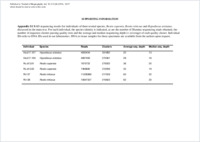‘Next generation’ biogeography: towards understanding the drivers of species diversification and persistence
- Lexer, Christian Unit of Ecology & Evolution, Department of Biology, University of Fribourg, Switzerland
- Mangili, Sofia Unit of Ecology & Evolution, Department of Biology, University of Fribourg, Switzerland
- Bossolini, Eligio Unit of Ecology & Evolution, Department of Biology, University of Fribourg, Switzerland
- Forest, Felix Jodrell Laboratory, Royal Botanic Gardens, Kew, Richmond, UK
- Stölting, Kai N. Unit of Ecology & Evolution, Department of Biology, University of Fribourg, Switzerland
- Pearman, Peter B. Landscape Dynamics Unit, Swiss Federal Research Institute WSL, Birmensdorf, Switzerland
- Zimmermann, Niklaus E. Landscape Dynamics Unit, Swiss Federal Research Institute WSL, Birmensdorf, Switzerland
- Salamin, Nicolas Department of Ecology & Evolution, University of Lausanne, Switzerland
-
30.01.2013
Published in:
- Journal of Biogeography. - 2013, vol. 40, no. 6, p. 1013-1022
Biodiversity hotspots
Cape Floristic Region
Diversification
Gene flow
Next generation sequencing
Phylogeography
RAD
Radiation
Speciation
Species cohesion
English
The drivers of species diversification and persistence are of great interest to current biogeography, especially in those global biodiversity ‘hotspots’ harbouring most of Earth's animal and plant life. Classical multispecies biogeographical work has yielded fascinating insights into broad-scale patterns of diversification, and DNA-based intraspecific phylogeographical studies have started to complement this picture at much finer temporal and spatial scales. The advent of novel next-generation sequencing (NGS) technologies provides the opportunity to greatly scale up the numbers of individuals, populations and species sampled, potentially merging intraspecific and interspecific approaches to biogeographical inference. Here, we outline these prospects and issues by using the example of an undisputed hotspot, the Cape of southern Africa. We outline the current state of knowledge on the biogeography of species diversification within the Cape, review the literature for phylogeographical evidence of its likely drivers and mechanisms, and suggest possible ways forward based on NGS approaches. We demonstrate the potential of these methods and current bioinformatic issues with the help of restriction-site-associated DNA (RAD) sequencing data for three highly divergent species of the Restionaceae, an important plant radiation in the Cape. A thorough understanding of the mechanisms that facilitate species diversification and persistence in spatially structured, species-rich environments will require the adoption of novel genomic and bioinformatic tools in biogeographical studies.
- Faculty
- Faculté des sciences et de médecine
- Department
- Département de Biologie
- Language
-
- English
- Classification
- Biological sciences
- License
-
License undefined
- Identifiers
-
- RERO DOC 31842
- DOI 10.1111/jbi.12076
- Persistent URL
- https://folia.unifr.ch/unifr/documents/302886
Other files
Statistics
Document views: 133
File downloads:
- pdf: 314
- Supplementary material: 121

